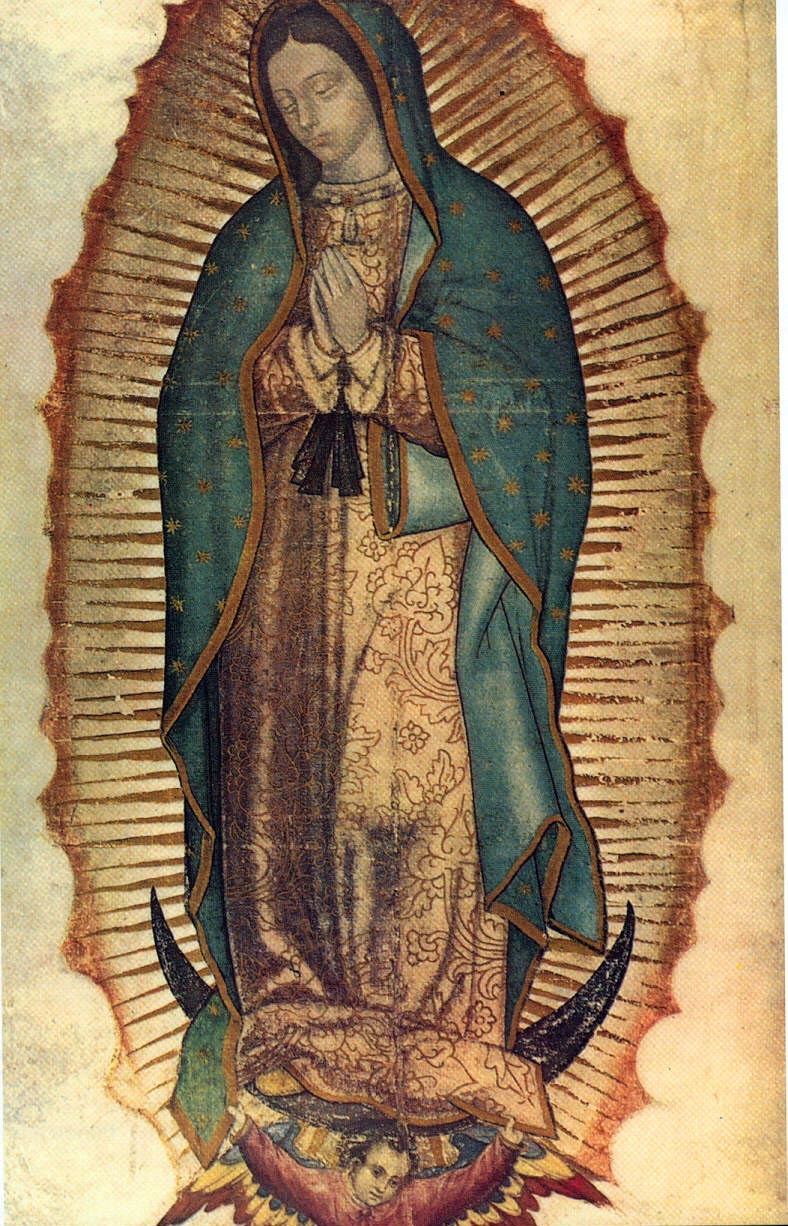
- Details
- By Pedro Noé Morales
In the early years of the Spanish occupation of the Americas, it was no secret that Spanish clergy distrusted the sincerity of Native people’s conversions to Catholicism. After all, their devotion to the Christian God had been imposed through violence against long-standing Native religious traditions. It should come as no surprise, then, that the Mexican devotion to the Virgin Mary of Guadalupe had its roots in the more ancient worship of Tonantzin Coatlicue (Our Mother Serpent Skirt), mother of gods and mortals, giver and taker of life. In Aztec lore, she symbolizes the earth’s power to both create and destroy.
Devotion attracted thousands of people to her home on the hill of Tepeyacac (usually written in its short form, “Tepeyac”) just north of the great city of Tenochtitlan. White smoke of copal filled the air at the top of the hill, the far-reaching sound of large ceremonial conch shells could be heard far and wide, and intricate and colorful dances as well as animal sacrifices were performed to please the goddess. All these theatrics were a spectacle that filled the Spanish religious and military leadership with fear, and reinforced their insecurities that their illegitimate presence might soon be repudiated by armed uprisings. However, these Christian leaders must have also salivated at the potential those masses held--to quench their own thirst for power and wealth.
From the beginning of the Spanish invasion of the Americas, Catholic symbols accompanied the mercenaries, bureaucrats and clergymen. There was no shortage of imagery depicting the Virgin Mary as white, such as the Virgin Mary of Sevilla. However, in the rural Spanish region of Extremadura, the birthplace of countless young men seeking fortune in colonial expeditions, a black Virgin Mary — in the monastery of Santa Mariá de Guadalupe — had a large following. She was brought to the newly controlled territories, where she would undergo a terrific do-over.
Want more Native News? Get the free daily newsletter today.
The story of the four apparitions of the Virgin Mary of Guadalupe is now legendary in Mexico. She reportedly appeared to a Christianized Indigenous peasant named Juan Diego between December 9-12, 1531, just 10 years after the fall of Tenochtitlan.
According to church lore, out of all the hills surrounding Mexico City, Our Lady of Guadalupe appears at the hill of Tepeyac, the same hill where Natives venerated Tonantzin. She instructs Juan Diego to alert the bishop of Mexico, Juan de Zumárraga, of her presence and instructs him to pass on her request to have a chapel built in her name at this particular place, so she can hear and protect the people of Mexico. After several failed attempts by Juan Diego to honor the wishes of the Virgin, he decides he can’t tell her the bad news any more, and decides to avoid encountering her again by changing his route home. The lady proves relentless and finds him nonetheless. Juan Diego falls to his knees and explains to her that Church authorities won’t grant him an audience, due to his lowly state, and that the bishop is demanding a clear sign from her before he will grant one.
She instructs Juan Diego to go up the hill and collect in his cloak the multicolored roses he will find blossoming. Of course, flowers do not bloom in December, but Juan Diego does as instructed. He finds the miracle flowers and returns to the lady with his cloak full of fresh-cut roses. She touches the flowers and sends Juan Diego back to see Bishop Zumárraga, instructing him not to show them to anyone else. Juan Diego follows her instructions and opens up his cloak, revealing her image miraculously imprinted on its rough cactus-fiber cloth, and the rest, as they say, is history.
However, no scholar has ever found any evidence of such devotion to the Virgin Mary, or any mention of the miracle of her apparition in any early communications among Catholic Church officials in Mexico. That leads people to see these claims as the result of religious piety rather than historical accounts. What is often missed, though, is that between 1531 and 1648, more than 90% of Mexico’s Native population perished as a result of war, exploitation, and disease. Those who kept records were in short supply, and it is understandable that only oral tradition may have kept the story alive.
It wasn't until in the middle of the 17th century when mixed-race clerics Miguel Sanchez and Luis Lasso de La Vega published the first claims on record of the origin of this devotion. Sanchez claimed to have gotten the tale from oral tradition, but never specified who witnessed these events or where the tale originated. Lasso wrote the claims in the Aztec language Nahuatl, likely as a way to advance efforts to Christianize more Natives. Analysis reveals that the Nahua version, although published in 1649, could have been written as early as 1550. There was a popular and classical medieval Spanish story of shepherd boys running into versions of Mary holding a child and asking a chapel be built on the spot of the apparition.
The image of the Virgin of Guadalupe is based on a Spanish Immaculate Conception template, as revealed by her feet standing over a crescent moon. Only now she wears a blue mantle depicting constellations, her hands are held in prayer, her eyes half closed as if looking down upon the faithful. The first recorded mention of the image is from around 1555-56, a time when numerous accounts discussed claims of miraculous healings, and colonial authorities were concerned that a growing devotion to a virgin painted by an “Indian” was gaining too much popularity and could work against Franciscan efforts to indoctrinate the Natives into proper Christianity.
This image, created by a Native, was neither black nor white; she was a tanned goddess, the first of its kind in the Americas. She was tanned like those marginalized, defeated souls coming to her for relief and mercy, something in short supply among her colonial representatives. She was tanned like those suffering the early effects of the long night of colonialism, and she also signified another iteration of Tonantzin Coatlicue, the powerful mother of gods and humans.
Catholicism and the colonial project survived in Mexico and beyond, thanks in no small part to the Virgin of Guadalupe and the devotion she commanded among the Native populations. Everywhere conquistadores went spreading death and destruction, there was a version of Virgin apparitions. Sometimes she was Black, like Our Lady of Charity of El Cobre, in Cuba about 1600, and sometimes white, like the Virgen de Luján, in Argentina in 1630. Many more appeared, in Chiquinquirá, in Colombia’s Boyaca province in 1586; Our Lady of Copacabana in Bolivia in 1576; and Brazil, when Our Lady of Aparecida (Immaculate Conception) made her presence known to fishermen on Oct. 12, 1717.
The story of all those apparitions followed the same formula. The adapted plot used in Mexico saw only minor changes to cater to whatever local marginalized community the Spanish invaders (or the Portuguese, in Brazil) needed to subdue. These apparitions gave people a feeling of agency, and the miracles imputed to them became at least as important as any royal mandate in cementing the Spanish Catholic identity that took hold in the Latin American colonies. No doubt both the secular elites also understood the power inherent in religion, and they and the Church wasted no time helping perpetuate through all aspects of culture the continuity of the natural devotion already deeply rooted in Mesoameircan societies. They knew full well the devastating social, economic, and political conditions they were inflicting upon Native people in the name of their God, and they needed a hopeful distraction.
Although the colonial rulers and religious authorities’ intentions were always self-serving, from the bottom up, the opportunity to call upon a deity in times of need was about all they had left to seek relief. The deep current of devotion to the sacred was there thousands of years before the long nightmare of Spanish occupation, and it continued on even as it merged with and hid within the symbols and tradition of Christianity.
The devotion to Virgin Mary is as real as the devotion to family among most Mexicans to this day. For many, Mexico was born at Tepeyac, and the devotion to the tanned Virgin remains deeply connected to the Mexican ethos even when many have stopped believing in the otherwise indifferent white God and his religious institutions and representatives.
More Stories Like This
Technology Rooted in Tradition is Strengthening Cherokee NationThe Lumbee Tribe of North Carolina: #575
Tribes Do Not Need a Greenlight to Build Renewable Energy
Law Should Not Get in the Way When "Manifest-ing Destiny"
Celebrating 35 Years of Gaming Success
Help us defend tribal sovereignty.
At Native News Online, our mission is rooted in telling the stories that strengthen sovereignty and uplift Indigenous voices — not just at year’s end, but every single day.
Because of your generosity last year, we were able to keep our reporters on the ground in tribal communities, at national gatherings and in the halls of Congress — covering the issues that matter most to Indian Country: sovereignty, culture, education, health and economic opportunity.
That support sustained us through a tough year in 2025. Now, as we look to the year ahead, we need your help right now to ensure warrior journalism remains strong — reporting that defends tribal sovereignty, amplifies Native truth, and holds power accountable.
 The stakes couldn't be higher. Your support keeps Native voices heard, Native stories told and Native sovereignty defended.
The stakes couldn't be higher. Your support keeps Native voices heard, Native stories told and Native sovereignty defended.
Stand with Warrior Journalism today.
Levi Rickert (Potawatomi), Editor & Publisher

